Sweet potatoes are a truly glorious vegetable. They are a root vegetable like the standard potato, but with a completely different texture and taste, and a huge supply of vitamins, minerals and other exciting health benefits.
You can, of course, buy your sweet potatoes (or yams – that’s how they are often marketed in the US) from the shop or the grocer – or, you could grow your own. How to grow sweet potatoes at home? Start by reading further for the best tips!
What You'll Learn Today
- What Are Sweet Potatoes
- How Do Sweet Potatoes Grow?
- Types Of Sweet Potato
- Sweet Potato Uses
- How To Grow Sweet Potatoes?
- What To Do With Bad Sweet Potatoes?
- Best Ways To Peel Sweet Potatoes
- How To Keep Your Sweet Potatoes?
- Companion Plants For Sweet Potatoes
- Are Sweet Potatoes Good For You?
- Dos And Don’t Of Sweet Potatoes
- Final Words
What Are Sweet Potatoes
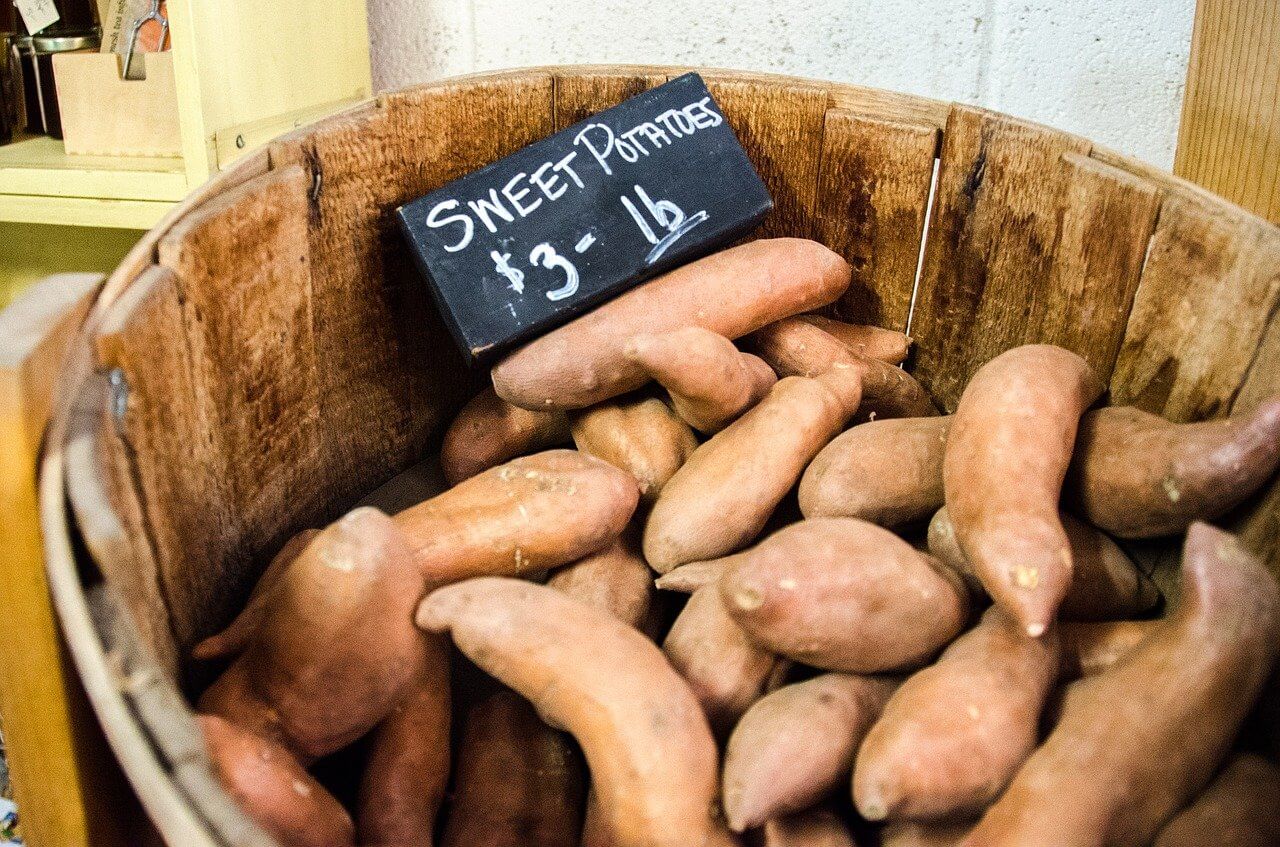
Sweet potato is the common name for Ipomoea batatas, a member of the Convolvulaceae, or Bindweed family. It is native to tropical regions of the Americas, where its flesh is prized for its sweet, soft texture when cooked.
Despite the name, sweet potato is not actually a potato! It is a root vegetable, but the name comes from Christopher Columbus’ explorations and the combining of the Spanish and Taino words for the various cultivars, which has turned into the word that we know today.
The sweet potato is an incredibly widespread vegetable, with many countries in the world enjoying its sweet flavor and smooth texture. In 2019, a whopping 113 million tons of sweet potato were produced, with more than half of that total coming from China.
How Do Sweet Potatoes Grow?
The seeds of sweet potato are generally only used for breeding, so the plants themselves are best grown from “slips”; the shoots that grow from the roots during storage.
They are long, winding plants that spread out their leaves to a fair distance, while the root develops underground, turning into the fleshy tuber we all know and love.
It can take as little as two months and as long as nine months to fully grow a sweet potato, depending on the type of weather and soil that you have.
Sweet potatoes grow best in well drained and light or medium textured soils, with an average temperature of 75 degrees F, and they are sensitive to both drought and waterlogged roots.
They are not generally susceptible to pests, so won’t usually need any types of herbicides, and as the leaves spread so widely they tend not to get surrounded and choked by weeds.
Types Of Sweet Potato
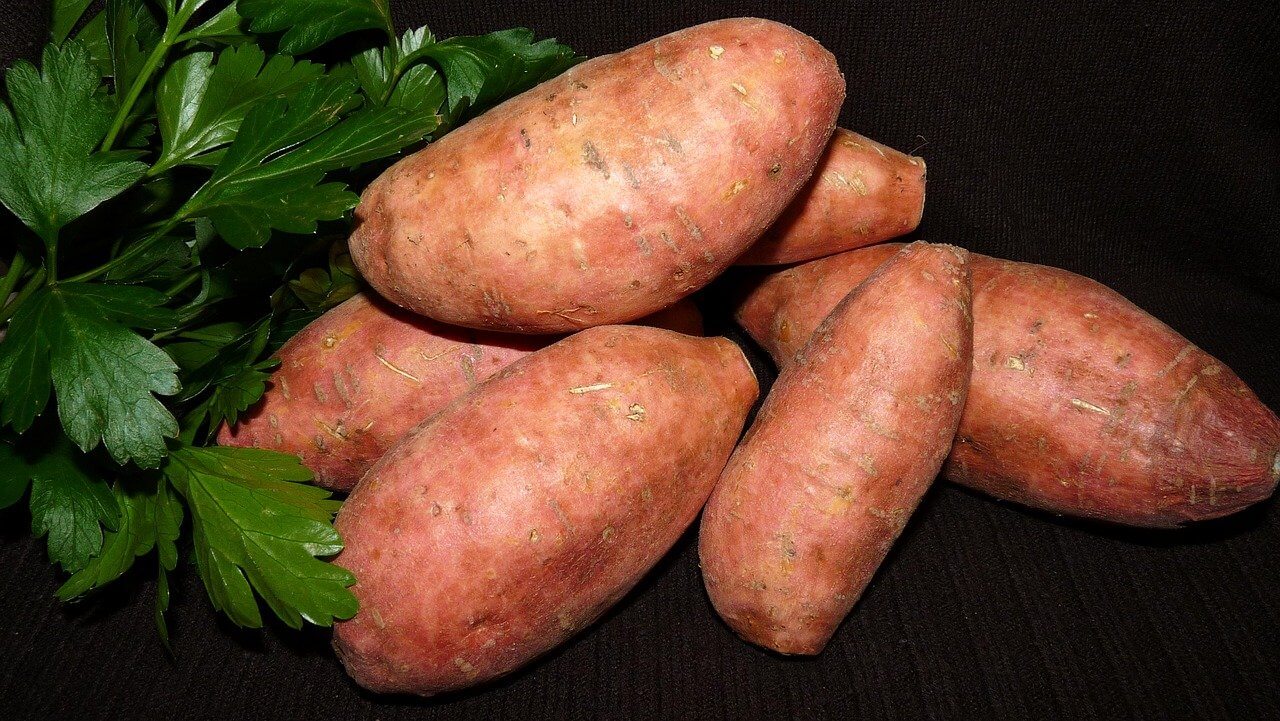
Although most of us think of that eye catching orange color and smooth flesh, when we think of sweet potatoes, there are actually many other types of sweet potato that come in different colors and have different textures:
1. Pale Sweet Potatoes
The most common variety is the Hannah, which has a cream colored, smooth skin, and a white flesh that turns yellow when it is cooked. This is one of the sweeter sweet potatoes, with flesh that is firm.
2. Purple Sweet Potatoes
Yes, these alien looking species exist! They are called Stokes Purple, and they are a startlingly deep purple color both when raw and cooked. They are, reportedly, not as sweet as some others, and the texture is quite dry.
3. Japanese Sweet Potatoes
The Japanese yam is a purple skinned potato, with flesh that starts out white then turns golden when it is cooked. It is one of the sweetest, with firm flesh.
4. Orange Sweet Potatoes
These are what most of think of when we think of sweet potatoes; the Garnet is a variety that has reddish or dark orange skin, and sweet, moist flesh when cooked.
This is a tiny snippet of the many different types of sweet potato; we’d need hours to tell you about all of them! But, as you can see, there are many different types you can choose from depending on the sort of thing you want to grow and cook.
Sweet Potato Uses
Sweet potatoes are so incredibly versatile; they can be incorporated into a huge variety of dishes and cooked in a multitude of different ways. They are incredibly healthy, and packed with nutritional benefits, and they will be delicious every way you try!
- Roast them as you would a potato, but you don’t actually need to use any oil, as the sweet potato is naturally more moist than its distant cousin.
- As chips. Sweet potato fries are healthier and even more delicious than normal chips – just slice them into matchsticks and bake!
- Can be incorporated into other dishes. Sweet potato lends itself to pretty much any dish – from curries to casseroles, and everything in between.
- As a potato substitute. If you are looking for a healthier diet but you love the humble spud, why not switch to its nutritional friend?
- Surprisingly, this root vegetable takes very little time to soften – and steaming it is the best way to retain all its nutritional benefits.
- In sweet or savory dishes. Although it is technically a vegetable, the flavor of a sweet potato means that it can be used in desserts too.
- Leaves can be used in salads. Don’t throw away the leaves from your plants! They make a great little salad, and can also be used as a spinach substitute.
How To Grow Sweet Potatoes?
The first thing you need to do is make sure the soil is warm enough. If you live in a cold area, or plan on planting your sweet potatoes in a shaded area of your garden, it may be worth looking into a greenhouse option or even grow them indoors.
Next, pick the most suitable soil. Light or medium textured soil which is well draining is the best option for sweet potatoes, and the soil should be a pH level of between 4.5 and 7.0.
Your sweet potatoes must be well watered as they are sensitive to drought, but you must also make sure that the roots don’t get waterlogged. Keep an eye on them 50 to 60 days after planting, as this is when they will need to be kept consistently moist.
This video is a useful first step to planting your sweet potatoes:
Pick The Best Soil For Sweet Potatoes
Sweet potatoes are relatively tolerant of different soil types, and will grow in poor soil – but heavy clay will deform the roots, and sandy soil may make them grow long and stringy.
The most important thing to consider when looking at the best soil for sweet potatoes, is that it must be warm. It needs to reach at least 60F, with night time temperatures above 60F.
You can prepare your soil by using fabric mulch, or even plastic sheeting, placed over the soil a few weeks before you decide to plant. This should warm the soil sufficiently that your little potatoes get off to the best start.
You should go for loose soil, that aerates well, and that is rich in organic matter. A good, all round compost will be great at delivering nutrients – but remember not to fertilize your sweet potatoes at planting time as too much Nitrogen will encourage larger leave and smaller tubers.
Sweet Potato Pests
Sweet potatoes are not actually a difficult plant to grow, in terms of keeping off insects and other creatures that might like to eat them. You may notice a few caterpillar holes in the leaves, but nothing that will destroy your precious crop.
One weevil native to the US, the Sweet Potato Weevil, will play havoc with your potatoes, both the leaves and the tubers – but you should be fairly safe if you don’t live in America! If you do encounter any unwanted visitors, planting aromatic herbs around your spuds will make a world of difference.
Sweet potatoes are vulnerable to fungal diseases such as Black Rot and Stem Rot – you can minimize these problems by only planting healthy slips, or by using resistant cultivars. If you notice your potatoes becoming infected, immediately remove and destroy the infected plant, and keep a close eye on the rest.
The leaves tend to spread out far, and will shade the soil underneath so well that you won’t have any problems with weeds – just make sure you keep the area free from weeds as the little plants are getting themselves established.
What To Do With Bad Sweet Potatoes?
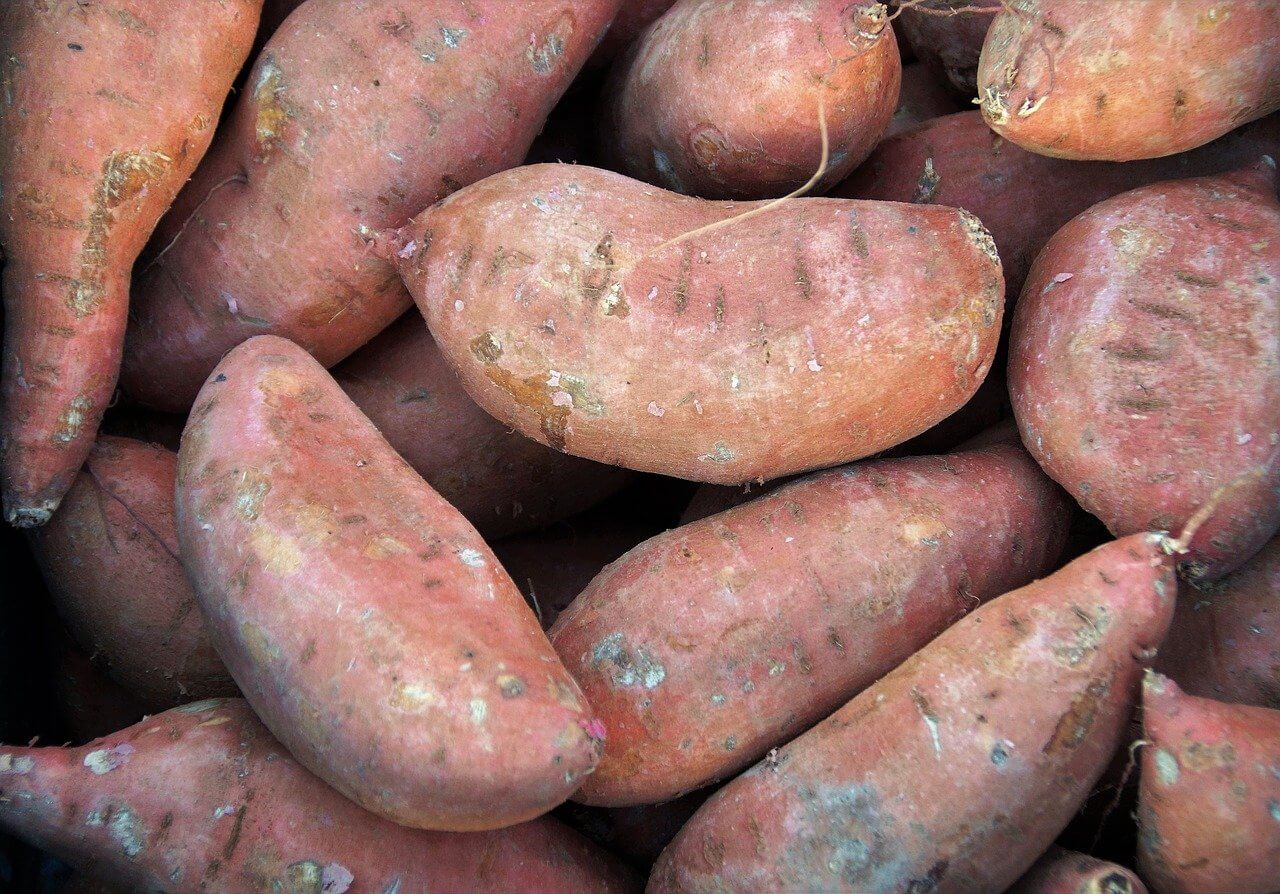
When sweet potatoes go fully brown, or moldy, or their texture changes or they smell funny, you should throw them away and not eat them. Eating moldy or gone over food can cause havoc with your digestive system, so it’s really not worth it.
If your sweet potatoes have one or two brown bits that are small and confined to only one area, you can remove this area and use the rest of the potato straight away.
Sweet potatoes that have tiny hole inside them are suffering from heat damage, and can still be used – though the texture and taste will be compromised.
Any completely brown or moldy potatoes should be removed from the rest of the batch and thrown away. I think it’s relatively easy to recognize if they have gone bad.
Keep The Color In Your Sweet Potatoes
When you’re preparing sweet potatoes, the reaction from the air with the cells of the root will turn the flesh an unattractive color. You can prevent this by dipping the cut pieces of sweet potato into citrus – lemon or lime juice is perfect – to prevent browning and bring out the vibrant natural color.
Best Ways To Peel Sweet Potatoes
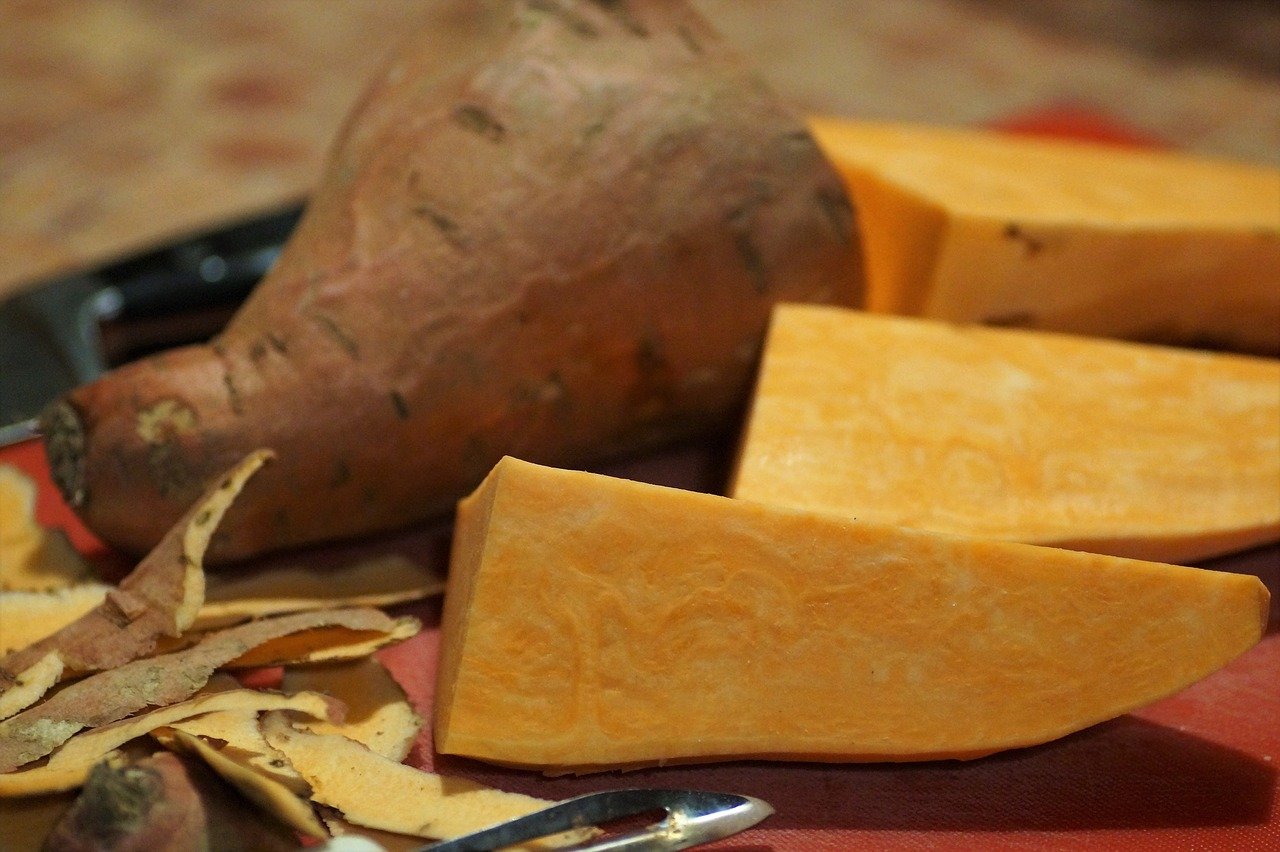
The skin of the sweet potato is loaded with nutrients, so your best bet is to eat the skins too. If, however, you want to peel them, there are a few ways:
- The most common way of removing sweet potato skin is to use a standard peeler – there are a huge variety of these, so it’s just a case of working out which type you like the best.
- If you don’t have a peeler, baking your sweet potatoes will make the flesh inside cook to perfection, while the skins will just slip off.
- Score a line horizontally around your sweet potatoes then boil them till they’re soft, then remove from the water and allow to cool. Next, simply rub the skin off – it’s super easy.
How To Keep Your Sweet Potatoes?
Storing sweet potatoes is relatively easy, and if stored correctly they should last for months. If not, they may sprout or just become unusable.
- Start by laying all the spud out to dry for a few hours, once you have harvested them and brushed off the dirt.
- Keep them in a well ventilated area, in single layers or at least not piled up on top of each other, for up to two weeks.
- Now they are “cured” you can move them to their final storage place – this should be again well ventilated, and at a temperature of no more than 15 degrees C, with a humidity of around 80%
Companion Plants For Sweet Potatoes
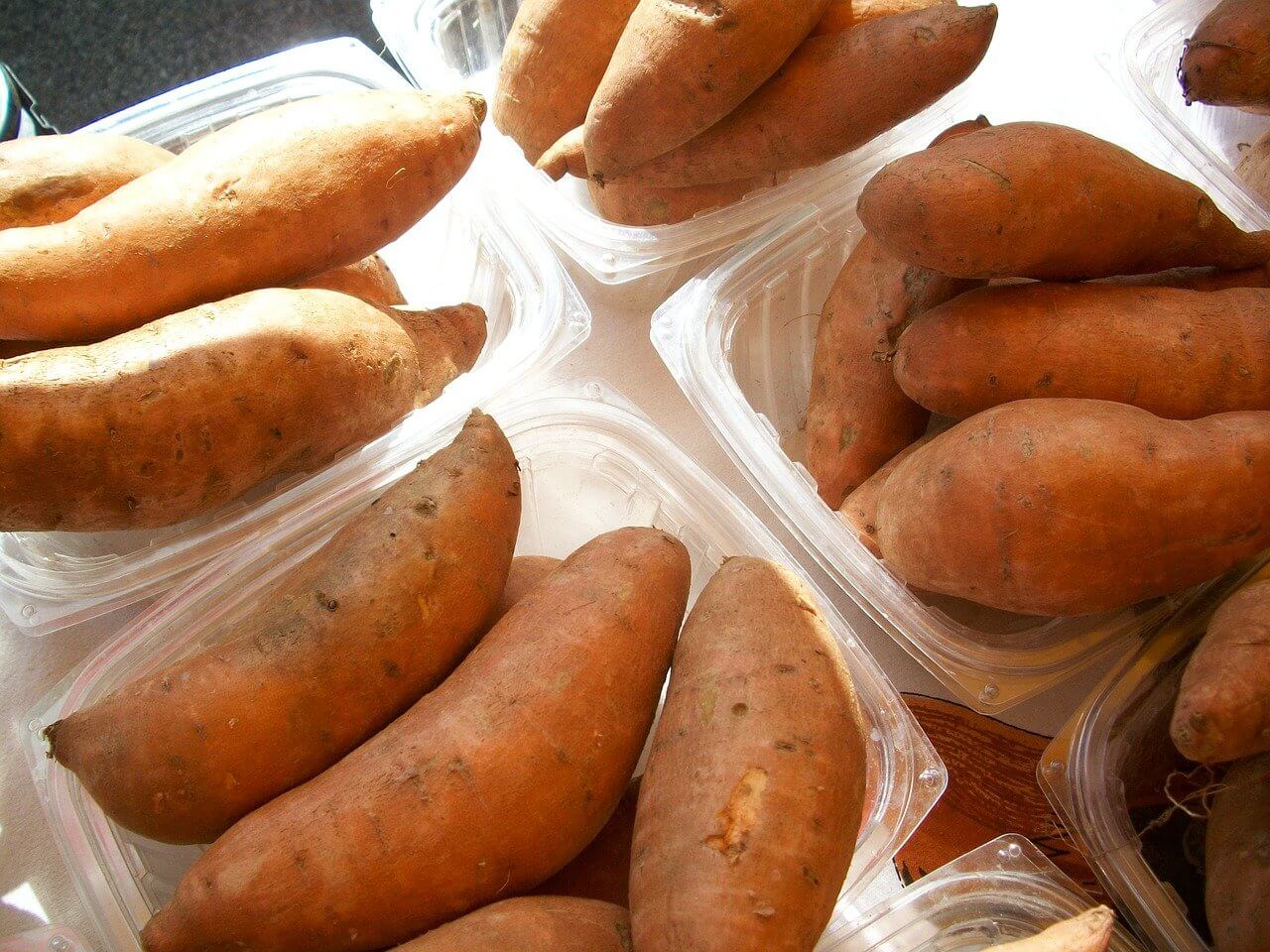
The rule of thumb with companion plants for sweet potatoes is, nothing too short, and nothing too vigorous. Plants that are short, and fruiting, will be overwhelmed by the spreading leaves and vines of the sweet potato, so pick something that can climb.
Root vegetables are another good idea – you might think that they would compete for space, but carrots, parsnips and beetroot tend to occupy shallower levels of soil and have shorter leaf structures, so they are ideal to plant with a sweet potato crop.
Aromatic herbs are another great bet, as they will grow easily with a little shade, and most are slow growing so they will not impede each other. The great thing about herbs is that they can deter pests from attacking your sweet spuds.
Are Sweet Potatoes Good For You?
Sweet potatoes are ranked as one of the healthiest foods that you can find. They are a starchy vegetable, with a lot of dietary fiber, complex carbohydrates, beta-carotene.
They also contain Vitamin B5, Manganese and Vitamin C (this increases when the potato is baked), while the Vitamin A in the beta-carotene is an excellent source of vitamin to reduce Vitamin A deficiency.
So the short answer is yes – they are good for you, and also for your livestock or dogs.
Dos And Don’t Of Sweet Potatoes
To sum up, when growing your sweet potatoes:
- DO plant them in well draining soil
- DON’T overwater them
- DO keep them apart from other fast growing leafy vegetables
- DON’T grow them too close together
- DO plant them in warm soil
- DON’T leave them out in a frost
This is a comprehensive and interesting video, that will show you a few must dos when growing your own sweet potatoes, and also highlights some of the different types:
Final Words
Sweet potatoes are a dream of a vegetable. They are packed with nutritional benefits; they are versatile to use and cook, and they are incredibly tasty. Growing them yourself is a much more fun way to keep them than to buy them in the shops – with the added bonus that you know exactly what has gone into them.
Now you hopefully have a better idea of how to grow sweet potatoes – and of what to do with your delicious crop – so get out there and get planting! And if you are looking for more growing guides, why don’t you look at this one about sunflowers.
Sweet potatoes are super delicious and healthy. Btw, the guide is very informative.